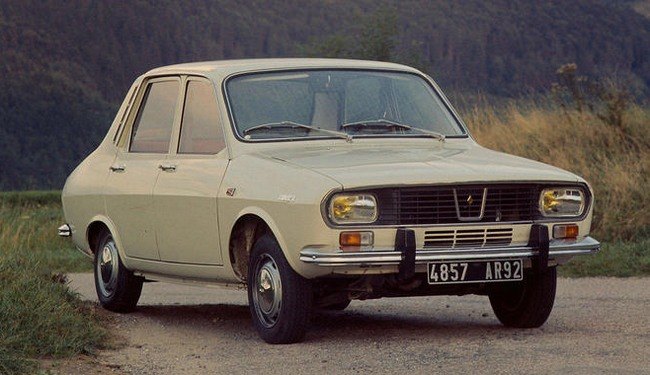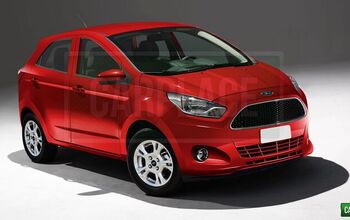Dispatches Do Brasil: 1975 Ford Corcel Luxo

The year was 1968 and it was a good one for Brazilian motorists. GM launched its Opala and Volkswagen its 1600 (sedan). Meanwhile, Ford launched its first car aimed at a broader swath of the market, the Corcel. Up until that time Ford aimed at better off consumers and commercial applications. Its only car was the Galaxie 500 and F100 pickup besides medium and large trucks. It signaled the future direction of the market in Brazil as this Ford was in reality a Renault…
Ford had acquired Willys Overland do Brasil in 1967. Besides such cars and trucks as the Aero Willys and Itamarati and Rural and Jeep (not to mention Renault Dauphines and Gordinis), Willys had been developing internally what was known as Project M. According to William Max Pearce, then Ford Brazil president, that Project was a very large part of the reason why Ford bought Willys out. He said that two prototypes were taken to Detroit and extensively tested before the Americans green lighted the purchase and as such, instrumental to the decision.
Willys had a history of working with Renault in Brazil. They built and sold here French products and worked together with them to adapt those cars to Brazilian conditions. When Willys started looking for a buyer, that Project was almost ready. Curiously, while it was launched here in 1968, Renault would only launch their final version in 1970. It was the R12 and lived on until recently having been well sold in Europe and elsewhere. It had a long career. Dacia, then an independent East-bloc automaker from Romania had close ties with the French and kept building the model until the present century (2004).
Ford purportedly did some work on the car though how much is anybody’s guess. Supposedly they beefed up the suspension and increased its course. Most of the mechanicals however were in fact developed during the Willys-Renault cooperation. The engine for example was all French. The Corcel was an important launch in Brazil as it showcased many technologies for the first time in Brazil. It offered such things as front wheel drive, five engine bushings, sealed cooling system, and an early version of a collapsible steering wheel. It was a small car, but partly because of the front wheel drive system it offered internal space of a medium car from back then. The trunk was large and finishing and decorations depended greatly on version, coming from quite simple, but correct, to almost sophisticated and sporty.
For Ford it also marked greater cooperation between the local and corporate units. To launch this car Ford invested in the local engineering team and a large degree of autonomy was granted. The car was well received in the market and got off to a good start.
Oon however, trouble struck. The Corcel gained a reputation of being impossible to align and incapable of going up hills, especially those paved with cobblestones (then so common) and in the rain many would park their cars and wait for things to dry out. This was due to the gutless but economic engine (68 hp according to the metrics then, about 55 today, and given more power over time) and distrust of front wheel drive (though DKW-Vemag had sold FWD cars in Brazil for more than a while). As such, sales took a major hit and the car was looking like a flop. This made the car a star of another first in Brazil.
In 1970, Ford did the first official recall in Brazilian auto history. All owners were called upon to head to the dealer and receive their free fix. The problem was that due to its unique setup, the front suspension looked like a traditional McPherson, but it was not. What Ford did was simple. They fixed the steering system at a predetermined point and called it good. The original Renault system was more sophisticated and varied that point according to how high the car was sitting. To get it right, some calculation and care was required and the after market and even the dealers were just not prepared for it.
The Corcel in its original form lived on until 1978, when a more modern looking one, the Corcel II, was launched. About 600 000 cars of this vintage were sold, taking into account all versions, coupe, sedan and station wagon. They are still a relatively common site on Brazilian streets, often terribly rusted and gutted. However, due to the many firsts and luxury versions it has always been a favorite of well-heeled collectors. Recently, Brazilians have experienced some prosperity and the car collection bug has started biting more middle class members. The numbers of well-kept Corcels and other cars of its time has increased on the streets. Though rarer than 80s cars, I see some of the 70s specials driven about.
Now I have had a chance to drive one. A kid I know bought one from his uncle. It is a 1975 Corcel Luxo. It has an improved 72 hp 1.4 CHT engine. I love the orange paint job and the interior is in good shape. The lines are crisp and slightly sporty. This is the coupe and it helps with the impression of sportiness. The back lights are different from what is done today and seems to me the part most stuck in the 60s. The front had the revised less chrome-y grill and looks quite nice. The greenhouse is tall and the beltline low, hinting of great visibility that I would later confirm. It is a tidy package that though dated is a timeless design.
This car was bought in 2007 and has been slowly been recovered over this time. They young man who bought it has been involved with the resuscitation since the start and plans on a making yet a few more changes to make it reliable. He intends to put it to use as his daily driver, driving it to university and his job and in his nightlife soon.
The car is on its original engine and marks a little over 90 000 km. The owner is sure that has turned over at least once, but they opened up the engine and changed all the parts to get it back to standard. They did a good job because the car fires up the first time you turn the key and runs smoothly and surely.
Getting on the go takes a bit of effort. The car does not have hydraulic steering so its necessary to muscle it a bit. The oversized (for today) steering wheel helps the effort and it not too bad as the wheels are just 13 inches and the tires have a nice sidewall. A note on those wheels, the Corcel might be the only three lugged Ford in history (yes, due to its French inheritance).
The gear box is the only non-original change made to the car. This orange Corcel uses a Ford Del Rey 5 speed box from the 80s. The original 4 speed was broken and hard to get when the time came to change it. The engagements are nice and crisp and can be done relatively fast. The seating position is correct with pedals, wheel and seats (though they do not recline) well-aligned. There is a surprising amount of space in the front though in the back space is at a premium. People must have been smaller back then as this car did fill family duty.
The ride is very soft. It absorbs the imperfections well and goes straight without the need for constant corrections. The steering once at speed is light, too, and very communicative. This all harks back to more pristine time and the driver does feel more in synch with the machine. None of the modern creature comforts are available and the car is not isolated from the driver. It is also relatively quiet too, with no overbearing noise from the finishing. The engine does intrude though, very much the faster you go. Of course, this has to do with the lack of air conditioning. As such, I drove about with the windows open to try to refresh some in this very hot Brazilian summer.
Because of the soft suspension and weak engine, this car is not a canyon carver. On curves it inclines more that any more modern cars I’ve driven. I was aware of this characteristic and thus looked out for it, but it will surprise those used to modern suspension set ups. Allowing for this and anticipating it, curves can be taken at speed. It helps that the brakes are relatively modern. This one sports front disk brakes and braking power and characteristics are similar to modern small Brazilian cars.
The interior is dark. Almost everything is black. Instrumentation is a delight and quite complete however. The design language used in this car is no longer in vogue and there are quite a few surprises on how the various knobs and commands function. Nonetheless, they are easy to use and for the most part visible, though not that intuitive for a modern driver. It also helps they are all very light to operate.
To me driving this car was surprising. I expected a more primitive experience, but it wasn’t except for the lights which were just awful and did a terrible job of illuminating. Maybe because this was a modern car from the get go with its front wheel drive and disk brakes. Maybe because so many Brazilian cars make use of small 1.0 engines that have (slightly) better performance. The Corcel did prove to me that it would be a fun daily companion.
The Ford Corcel. A French Ford. A purveyor of many firsts in this country. Now a kid’s first car. May it go on pleasing its owner for a long time as it has undoubtedly has many other owners since it was built 1975.

More by Marcelo de Vasconcellos
Latest Car Reviews
Read moreLatest Product Reviews
Read moreRecent Comments
- Cprescott I'm sure this won't matter to the millions of deceived Honduh owners who think the company that once prided itself on quality has somehow slipped in the real world. Same for Toyoduhs. Resting on our Laurel's - Oh, what a feeling!
- Jrhurren I had this happen numerous times with my former Accord. It usually occurred when on a slow right curve in the road. Somehow the system would get confused and think the opposite lane (oncoming traffic) was an impending head-on collision.
- Cprescott The Ford Shamaro is ugly, thick bodied, and a Mustang pretender.
- Analoggrotto Speaking of mud, does anyone here enjoy naked mud wrestling?
- Jkross22 Nope. Too expensive, too little wear. Besides, there are so many great all seasons that are great to use that last longer, the use case for summer tires has gotten smaller.






















































Comments
Join the conversation
I'm surprised Ford didn't have the British market Cortina in mind for the Brazilian market - or did they? Too high priced?
Marcelo; I recently recieved a 1960 Falcon diecast (by Yatming.) When I placed it next to my completed Corcel paper models; I realized the Corcel's front grill resembles that of the Falcon: https://www.flickr.com/photos/75105572@N08/15996738864/in/photostream/ In side profile, it resembles the 1966-1970 Falcon, like this Junkyard Find: http://www.thetruthaboutcars.com/2011/03/junkyard-find-1970-ford-falcon-futura-sedan/ Finally, I also completed a paper model of the Corcel II: https://www.flickr.com/photos/75105572@N08/15999168423/in/photostream/ Both Corcel marks are an interesting combination of European and North American styling on a French design.